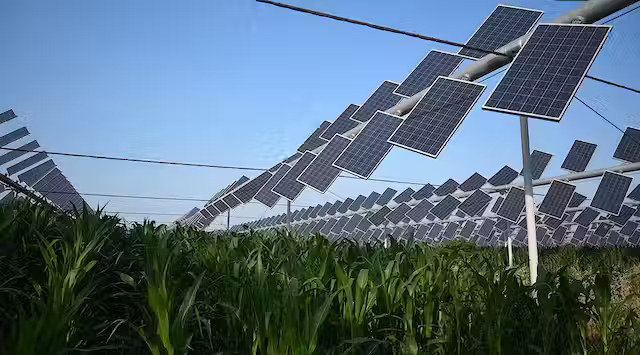In the picturesque town of Au in der Hallertau, Germany, a pioneering collaboration between Josef Wimmer, a hops farmer, and local solar technology firm Hallertauer Handelshaus is taking root. This unique endeavor intertwines agriculture and solar energy, leveraging the synergy between hops cultivation and solar power generation.
Vivid green vines reach skyward, entwining with solar panels suspended 20 feet (six meters) above Wimmer’s fields. These panels not only harness the sun’s energy but also provide essential shade for the hops, a crucial ingredient in beer production. This innovative approach offers a twofold solution: sustainable energy production and climate-resilient crop cultivation.
The concept of agrivoltaics, where solar panels are integrated with agricultural lands, has gained momentum globally due to escalating incentives for clean energy and the pressing need to adapt to climate change. Researchers and farmers alike are exploring ways to maximize land use, shield crops from intensifying heat, and potentially enhance yields.
Trending: Maui Wildfires Claim 53 Lives, Prompting Biden’s Disaster Declaration
In Wimmer’s pilot project, the electricity generated can power approximately 250 households. Importantly, the shaded environment created by the solar panels ensures the hops receive the optimal balance of sunlight and protection, a crucial consideration in an era of amplified summer heat due to climate change.
Bernhard Gruber, overseeing the solar component of the project, notes that excessive sun exposure can harm beer-making hops. By providing shade, the solar panels mitigate solar stress, potentially resulting in longer-lasting moisture in the soil, healthier hops, and increased disease resistance. A scientific evaluation of these benefits is anticipated to conclude in October.
Agrivoltaics is not confined to hops alone. Across the globe, similar projects have sprouted, encompassing a diverse range of crops, from grains to fruits and vegetables. In the UK, researchers are investigating the integration of solar panels with greenhouses or polytunnels, structures that shelter crops. The transparency of these installations allows sunlight to filter through, creating an optimal growth environment. This innovation contributes to efficient land use and bolsters crop resilience in the face of changing climatic conditions.

East Africa, facing the ramifications of prolonged drought exacerbated by climate change, is also harnessing agrivoltaics. Solar panels serve as shields, retaining moisture and minimizing water usage for crops. Richard Randle-Boggis, a research associate at the University of Sheffield, is spearheading agrivoltaic initiatives in Kenya and Tanzania. The outcomes have been encouraging, with enhanced yields for various crops and a reduction in irrigation requirements. Clean energy production further accentuates the benefits of this symbiotic approach.
Also Read: North Koreans Urged to Protect Kim Dynasty Portraits Amidst Tropical Storm Khanun
These endeavors underscore the versatility and promise of agrivoltaics. As climates evolve, the integration of solar panels with crops holds potential to enhance agricultural sustainability and mitigate environmental challenges. From providing shade to conserving water, the marriage of solar technology and agriculture ushers in a future where resilience, innovation, and sustainability intertwine seamlessly.
FAQs
Q1: What is agrivoltaics?
Agrivoltaics is the practice of integrating solar panels with agricultural lands, offering both clean energy generation and climate-resilient crop cultivation.
Q2: How does agrivoltaics benefit crops like hops?
Agrivoltaics provides shade and protection for crops, shielding them from excessive heat and solar stress, potentially leading to increased yields and disease resistance.
Q3: How is agrivoltaics being implemented in the UK?
Researchers in the UK are exploring the integration of solar panels with greenhouses or polytunnels, optimizing sunlight exposure for crops.
Q4: How does agrivoltaics contribute to sustainability in East Africa?
In East Africa, agrivoltaics helps retain moisture in plants and soil while reducing water usage, thereby enhancing climate resilience and clean energy production.
Q5: What is the potential for agrivoltaics to expand globally?
Agrivoltaics offers a versatile solution for diverse crops and climates, presenting an opportunity to enhance agricultural sustainability and adapt to changing environmental conditions.

